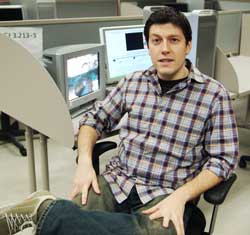Journalism class finds audience

Elias Makos, Journalism technical director, started uploading students’ work on to YouTube. The result is a popular outlet for student reports.
photo by Kate Hutchinson
Constantly subjected to the complaints of journalism students that their hard work is neither seen nor heard outside the department, Elias Makos decided to do something about it.
“I’ve always heard the comment, ‘No one’s listening to this, no one’s watching this,’” said Makos, the department’s technical director.
As a graduate of the Concordia journalism program, he could certainly understand their frustration, so last winter, he decided to surprise professor Peter Downie’s Advanced Television students by uploading their work to YouTube, a popular web site that allows just about everyone to post videos for the world to see.
That was in March 2006. Makos has since uploaded 13 reports from the Advanced Television class and the diploma program under the name Concordia Broadcast. He estimates that the segments have been viewed nearly 3,800 times, with some individual videos getting up to 500 hits — exposure television students are happy to get.
“Where’s the audience? You’re putting all this effort into something no one sees,” said Misha Warbanski, echoing the sentiments of her Advanced Television classmates. “I think a lot of students feel that ‘if I know it’s going to be on YouTube, I’m going to put a lot more effort into it.’”
Like the most recently uploaded video, a special report on consumerism for Buy Nothing Day produced by Warbanski’s TV group. “It’s absolutely fantastic,” Makos gushed. He feels that the advanced broadcast students have always been enthusiastic about producing radio and television programs, but that the department’s presence on the Internet has given students an added incentive to step it up a notch.
Based on the success of the YouTube project, Makos will upload the introductory television class’s final newscasts, and has begun podcasting the Advanced Radio students’ programs as well. As far as Makos can tell, no other journalism department in Canada or the U.S. has consistently uploaded its students’ projects.
“For the most part, the reaction has been very positive,” Makos said. “We’re not only trying to highlight students’ work—we’re trying to highlight the department as well.”
Peter Downie, a CBC veteran and much-loved broadcast journalism professor, knows most students will take professional exposure any way they can get it, and YouTube provides the department with an excellent medium to do so.
“Peter thinks it’s great. He’s been really supportive, and he takes a lot of pride in his students,” Warbanski said.
Tune into www.youtube.com/concordiabroadcast for students’ videos.